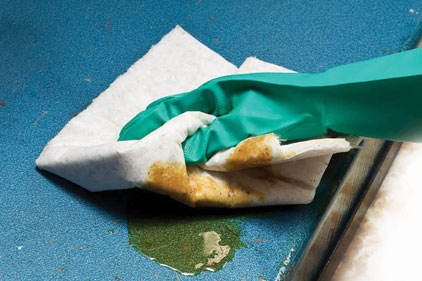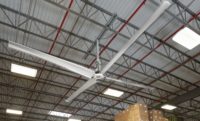Keep your facility clean
Control & contain industrial fluids & chemicals

When it comes to keeping your facility clean, there’s more at stake than general tidiness. An effective clean-up approach for routine leaks, drips and spills can greatly affect employee safety, regulatory compliance and your bottom line, depending on how you control and contain industrial fluids and chemicals at your facility.
For most spill cleanup and prevention, you may already use absorbents throughout your facility. Absorbent products typically include pads, pillows, rolls, socs and granular absorbents. However, an overwhelming number of businesses don’t always use the right type of absorbent for the application. You may be surprised at the savings and efficiencies you can gain by making a few adjustments to your absorbent usage.
Using absorbents to improve safety
The number one cause of accidents in industrial facilities is slips, trips and falls, accounting for approximately 20 percent of all workplace injuries.
A major source of these incidents are hazards caused by leaks and spills from substances such as oil, lubricants, coolants, cutting fluids, battery acid, solvents, chemicals and fuel. They can occur virtually anywhere in the plant, but often near equipment, in high-traffic areas and wherever fluids are handled and stored.
Our goal is — and regulations require us — to keep floors and work areas clean and dry. It’s a significant challenge, especially in facilities where overspray can coat work surfaces, stairs and walkways with an oily film. Slippery surfaces not only endanger employees on foot, but can also affect equipment such as a forklift’s ability to navigate and maintain proper traction on a slippery floor. This creates very unsafe conditions where injuries and spills are likely to occur, while reducing productivity.
Absorbents have improved greatly from the granular absorbents that were traditionally used to control spills and give employees traction on a slippery floor. Some companies still use clay to absorb spills, but the cleanup is a relatively messy, inefficient process with high labor costs. Others rely on a mop and bucket with a cleaner or degreaser. But there’s almost nothing more slippery than spreading soapy water on top of an oily surface. These methods add labor, decrease productivity and increase risk of injury.
Instead, try placing the appropriate absorbents at the source of a leak, such as positioning socs, pads or pillows up against machinery. Install durable, absorbent rugs or mats in high-traffic areas to reduce risk of falls and improve traction for employees and equipment. For specific guidance on how you can create a safer plant, you should consider an absorbent usage survey conducted by an industry professional. These surveys are often done free of charge. A thorough survey can help you identify specific areas and ways to improve safety through proper absorbent usage.
Soak up productivity, wring out MRO costs
Leaky or spraying machinery is a fact of life for most manufacturing plants. No manufacturer wants to shut down its production mid-process to fix a minor leak — the cost in lost productivity can be astronomical. Sometimes it is far less costly to simply contain a leak or spill with absorbents until a repair can be made later.
Do you know how well your absorbent products and containment practices are really working? An absorbent usage survey can reveal some eye-opening savings opportunities.
Here is an example. One company was spending $100,000 per year on absorbents at its metalworking facility. They were using basic white bales of absorbent pads and were entertaining bids on those products with a price differential of only 50 cents. The absorbent supplier did a complete analysis of the usage from purchase through disposal, and ultimately recommended a seemingly more expensive high-traffic roll product instead of the basic bales of white pads. There were two reasons: first, the rolls were perforated to provide flexible-size pads as needed. Second, although the new rolls had a higher purchase cost, they were more durable and lasted longer than the pads. In a two-week product comparison test, instead of using 50 bales of pads, the company reported using only eight of the rolls. Not only did the company save 14 percent on product cost, it also saved a whopping 40 percent in usage reduction and disposal costs, for a total of $47,000 or 47 percent in absorbent-related cost savings.
As this example shows, how you dispose of used absorbents also affects your bottom line. It starts with the kind of absorbent you use. Some absorbents are more labor-intensive or costly to dispose of; others have less absorbency and must be disposed of more often, using more product and time. More frequent disposal also means more frequent replacement of absorbents, requiring additional time.
You may also want to assess the basis weight and disposal timing of your current absorbents. Are you using and throwing away a heavyweight absorbent that only has a few drops of oil on it or is only partially saturated? You might save on purchase and disposal costs by using a medium or lightweight product. Additionally, you may have the right product, but are simply disposing of it too soon.
You can also improve employee productivity and efficiencies by placing “absorbent centers” with supplies and instructions near the areas of greatest need. This can save time when employees need absorbents for routine maintenance as well as emergency spill response.
Improve compliance
Absorbents can play a vital role in compliance with local, state and federal regulations. Inside your facility, OSHA requires clean, dry workplace floors. Outside your plant, Department of Transportation (DOT)-specified containers and suitable quantities of absorbents are to be kept available for spill response. The Environmental Protection Agency (EPA) also requires you to control sources of storm water runoff and to have people and plans in place to clean up any hazardous waste discharged into the environment.
If you’re cited for non-compliance, it can cost you thousands of dollars in fines. You simply can’t afford to risk worker safety or allow industrial chemicals and solvents to escape your facility and harm the environment.
Almost every facility is required to have a plan for Spill Prevention, Control and Countermeasure (SPCC). Strategically locating spill kits should be part of that plan. A professional supplier can help you identify where to place spill kits and ways to comply — both inside the plant for spill containment and control, and outside of your facility to be used as countermeasures to minimize environmental impact if a spill occurs.
Training is also a required part of your SPCC plan. Once you have a plan, your absorbent supplier may be able to assist in training your employees on absorbent product usage, which can help you to implement your plan and comply with regulations.
The bottom line is, when you need absorbents, don’t just pick a product from a catalog because it looks similar to what you have used, or because the machinery in the picture looks similar to what your facility operates. Arrange a survey to address the unique needs of your plant — even consider an annual survey to keep you updated about how changes in absorbent technology, products and regulations may affect your business. A knowledgeable supplier can identify opportunities, offer cost-saving absorbent solutions, and advise you on how to achieve compliance.
Looking for a reprint of this article?
From high-res PDFs to custom plaques, order your copy today!






